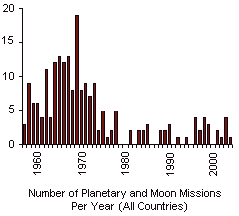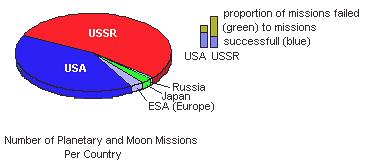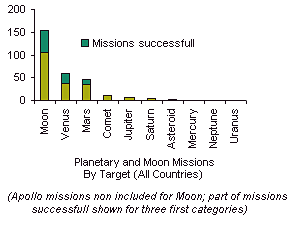
->A Alternate Source of Interest!
note! a remarkable NASA .PDF listing, with details, all planetary missions -by nations other than the USA included- since the Space Age began is available at that NASA page, or from our site directly (in case that page would turn unavailable, we even copied the text into a .txt file). That NASA source also holds a summary of all the missions concerned like a table by the end of it. Those documents, in terms of comprehensivity and details, may be considered superseding our own data (we let those in place for now); on a other hand, our 'Recentest Space Telescopes, Solar Missions and Science Missions (ab. 1990-now)' below may hold missions not refered to in NASA .PDF / NB: un .PDF remarquable de la NASA (en anglais seulement malheureusement), qui liste -avec détails- toutes les missions planétaires -celles des nations autres que les Etats-Unis comprises- depuis les débutes de la conquête spatiale, est disponible sur cette page NASA ou directement depuis notre site (dans le cas où cette page finirait par ne plus être disponible, nous avons même transformé le texte en un fichier .txt); le texte NASA contient aussi, à la fin, un tableau résumé de toutes les missions évoquées. Ces documents peuvent être utilisés au lieu de nos propres listes -que nous laissons en place pour l'instant; par ailleurs notre liste "Recentest Space Telescopes, Solar Missions and Science Missions (ab. 1990-now)" ci-dessous peut contenir des missions auxquelles le .PDF de la NASA ne réfère pas
This overview of planetary and Moon missions is listing all missions performed worldwide, starting in 1957 and down to now, Apollo program missions having actually gone to Moon included (the list is regularly updated). This missions list have been improved from a list available at the National Space Science Data Center (NASA Goddard Space Flight Center)
to missions list; a list of recentest space telescopes, solar missions and science missions is also available
After having been the first nation to successfully put an artificial satellite into orbit, USSR immediately turned to the Moon, Mars and Venus. Mars program was alleviated about 1964 to be renewed in 1970 only as Moon was aggressively targeted, but abandoned about 1976. Venus was stunningly agressively targeted by the Russians and this interest remained until about USSR's end. As far as the USA are concerned, their immediate interest was Moon, following President John F. Kennedy's speech. Such an interest was a success which eventually culminated about the end of the 1960s with the successfull Apollo missions. On the other hand, Mars and Venus were targets along with Moon, but in a much lesser quantity than the Russian missions. The interest for planetary missions came back mostly in the 1970s with missions to Venus, Mercury, Mars, and the gas giants. Followed a lull of about 10 years. USA were back again in outer space since about 1990. Mars is aggressively targeted since as are comets and asteroids, along with some more missions to the gas giants. Following diagrams allow to see how the second half of the 1960s saw a high tide of missions, how the USA and the former USSR dominated the scene, or how Moon, Venus, and Mars were the most visited targets. NASA considers that planetary missions lasted during five decades, beginning with the exploration of Venus and Mars in the early 1960s, and continued through first looks at Mercury, Jupiter and Saturn in the 1970s and Uranus and Neptune in the 1980s. Missions lately reached to a third zone, the one of Pluto and the Kuiper Belt
Since the mid-1990s, NASA has required all of its planetary missions to archive data in the Planetary Data System (PDS), an active archive that makes available well-documented, peer-reviewed data to the research community then the public


